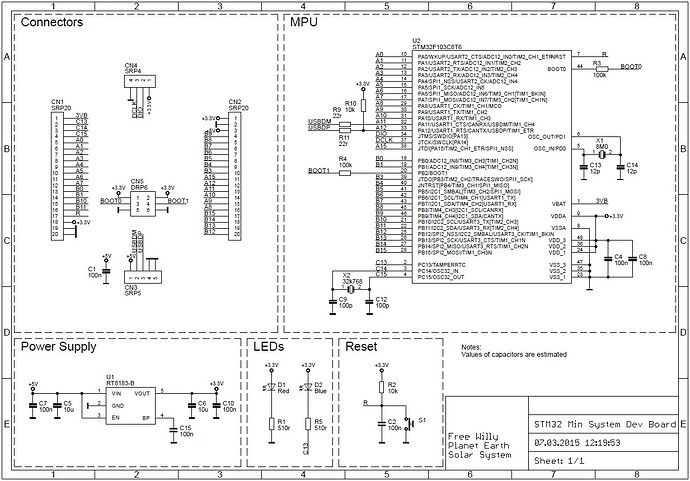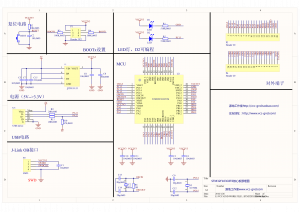Not that the world really needs yet another. However in my rummaging for a clean and unified schematic for this board I came up short. So I did a quick take-off relative to a few slightly different boards at hand which is attached. Feedback pointer in schematic.
blue-pill-schematic.pdf (37.4 KB)
Yes, as stated, precisely the motivation.
That's the thing. AFAIK, the "blue pills" are just implementations of the ST "Reference Schematic", from:
https://www.st.com/resource/en/application_note/an2586-getting-started-with-stm32f10xxx-hardware-development-stmicroelectronics.pdf
I think I'm confused. How is the fact there are already schematics out there a motivation?
I encountered both printing issues with the embedded chinese character fonts and the fact the existing schematics weren't a conventional integrated drawing. The capture here was offered in the event it would be useful to others facing similar issues.
I like your design. Thanks.
Yup, it's nice!
OK, but to make a critical remark on this: while your rendering is a unified schematic, it does simply switch the functional blocks for an equally opaque bus. Not that it matters a whole lot since you need to deal with the plethora of nets in some way. But in the end, it doesn't matter much which option is adopted, as long as all nets are labeled clearly.
Technically speaking, your design is a few decoupling caps short. But it'll work as is.
I'd also prefer a slightly more beefy regulator; the XC62xx are nice for their low dropout, but they're also very frail devices and prone to destructive decomposition if pushed only very slightly out of their comfort zone. Especially the XC6219 is a little tricky with its 6V max input; it doesn't take much to fry it. Omnipresent and equally cheap AMS1117 is a little more crude, but also stands up better to abuse.
NB: this isn't my design but rather an attempt to document the standard issue Alidepress blue pill boards shipping at present -- warts and all. While there seems to be minor variation in the actual PCB layouts, the electrical schematic reflects what I've received among the variations from China Inc. of late, and differs from the older schematics I've encountered rummaging online. That difference was the motivation to document what I've wound up with and I speculated what others have been receiving at present. Having sunk time to capture the schematic, I thought to amortize my effort by sharing with others. No more, no less.
And yes I agree if this had been my handiwork I'd have sprung for full boilerplate decoupling at all VDD/GND pairs. In fact I intuitively had them in the drawing when originally sketched up. But then realized this didn't jive with the PCB and pulled out the caps formerly @ 47/48 and 8/9 to most accurately reflect the PCB.
FWIW I've designed several STMF103xxx boards over the years which adhere to a more conventional approach. However it is tough to beat a US$1.50 delivered blue pill board as a quick and cheap experimenter's platform. Particularly when compared to the alternative of mounting a LQFP in a test socket or reflowing to a board to determine whether you've received a handful of duds or not. So given that proposition I decided it was marginally worth the time to capture an accurate schematic as a resource for the boards I've accumulated.
it is tough to beat a US$1.50 delivered blue pill board as a quick and cheap experimenter's platform
I bought a couple of those (amzn) and they had fake STM32's.
Had to get genuine uC's from DK - and swap them out.
As a side effect I accumulated a bag of free Bluepills over the years. Ordered some, filed a claim when I received fakes, got a refund and tried again to buy genuine boards. That turned out to be impossible, even when informing the sellers about what I would do when getting fakes. So when I need a genuine STM32 per-se, I do what @runaway_pancake mentions and swap the MCU.
The GigaDevices and CKS fakes are usually fine for my simple applications.
It isn't clear to me the extent non-ST origin silicon is passed off as genuine. Some LQFP silicon sellers do list what they'd have you believe are actual ST parts alongside of Chinese clone versions. But the cost differential is only a few cents which seems hard to fathom. Then again the knock-offs aren't being fabbed from scratch in a Shenzhen boiler room but rather likely the same ARM licensed M3 cores and subsystem IP, plus whatever 3rd party glue is required to create a work-alike device. I suppose bottom line is if it functions equivalent to the original for a given application, it doesn't make much difference. All of this strikes me as somewhat comical as there was a time in this industry a component wouldn't be designed into a product unless a second source existed for the part.
I've had junk SMD silicon arrive from Aliexpress sellers in the past and since have created socketed test boards to perform some degree of validation on parts received. My point above concerning blue pill modules being they invariably arrive with the 4-pin SWD connector already installed so a quick test with a debugger will indicate whether or not you've received complete duds. I've received BP boards which when flashed would run code at double execution speed of the PLL configured clock rate. But would then lose the contents of "flash" just when reset.
This topic was automatically closed 180 days after the last reply. New replies are no longer allowed.

